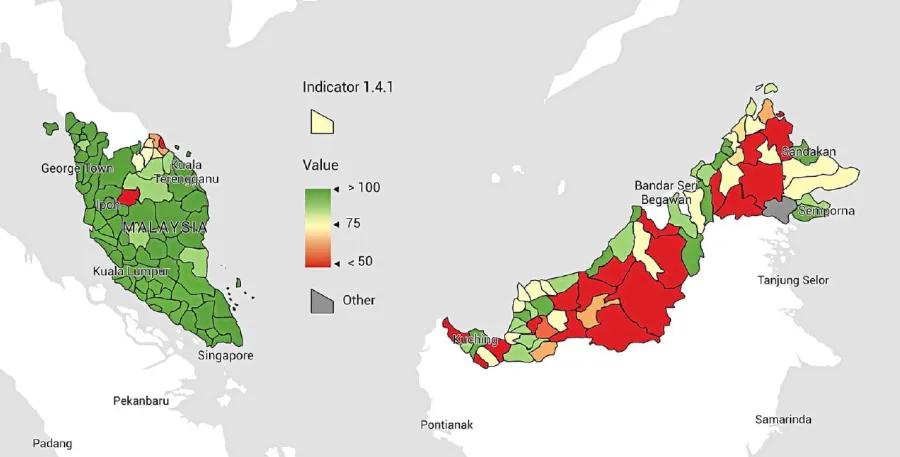Malaysia’s Progress on SDGs

On Sept 25 of 2015, Malaysia —together with 192 United Nations (UN) member states — adopted 2030 Agenda for Sustainable Development.
As a global collective blueprint, the 17 Sustainable Development Goals (SDGs) is a call for all countries in the world to promote prosperity and protecting the planet. In Malaysia, our Economic Planning Unit (EPU) by the Economy Ministry is tasked as focal point for sustainable development and each country is responsible review and follow up on the progress of the SDGs.
According to Sustainable Development Report (SDR) 2023 — produced by UN Sustainable Development Solutions Networks (UN SDSN) — Malaysia ranks 78 out of 166 assessed countries of the report.
Re-strategising our efforts
Malaysian SDG 2023 performance warrants deep rethinking and strategy in achieving the 169 targets across 17 SDGs. Out of the 17 SDGs, Malaysia only achieved a desirable SDG level for one goal, that is ‘Goal 1: No Poverty’.
However, SDR 2023 assessment of Goal 1 is centred on proportion of population living under and close to extreme poverty.
According to SDG 2023 report, Malaysia does well in the following indicators:
- Elimination of extreme poverty
- Basic health indicators.
- Literacy.
- Access to electricity.
- Access to water in urban areas.
- Internet penetration.
- Managing fish stock.
As we pass through the midway point of our SDG journey, it is important to know which indicators the nation is doing well in, and where we’re being held back in terms of SDG progress.
Indicators and performance
Jeffrey Sachs Center (JSC), Sunway University, is a think tank dedicated to the research and promotion of sustainable development.
JSC took on the challenge to conduct a state and district level assessments of SDGs in 2022 for the Malaysian public and other stakeholders to understand the challenges of various states and districts face. The study was
completed just this year.
Largely using 2019 data, each state was assessed across 17 SDGs with the exception of Goals 12 and 13 due to lack of data. For the SDG state level assessment, the states and territories with the best SDG performance were the Federal Territories, whereas Kelantan sat at the bottom of the list, corresponding to its economic development.
That said, however, the ranking revealed that states with lower economic performance such as Negeri Sembilan and Pahang are more sustainable compared to states like Selangor, Penang and Johor.
High gross domestic product (GDP) output and rankings does not mean a state is being developed sustainably.
Collective responsibility
All Malaysian states have achieved the ‘Goal 7: Clean and Affordable Electricity’ and have disconcerting performance levels on ‘Goal 2: Zero Hunger’.
As the SDGs are collective responsibility of all tiers of government, private sectors and the public, the state level assessment highlights the effects of centralisation and decentralisation of services.
Since healthcare is a federal responsibility and sanitation is centralised for Peninsular Malaysia, Malaysian states have attained SDG targets for basic indicators such as access to safely managed sanitation, maternal mortality ratio and neonatal mortality rates.
On the other hand, indicators relating to water such as access to clean water and managing water ambience in river basins varies in performance across multiple states as water is largely domain of the state
governments.
Indicators like Goal 1 and Goal 2 are under domains of federal and state responsibilities have disturbing levels of underperformance that include stunting, wasting and urban-rural poverty gap among other indicators.
The JSC website on SDG State level assessment is accessible via this link.
Addressing the gaps
Building on the success of state level dashboard, SDGs Today — an arm of UN SDSN — partnered with JSC and UN SDSN’s Asia office to develop a district level assessment. Since the SDG state level assessment pointed to variations in performance, the district level assessment is intended to examine which areas of the state are underperforming.
Due to data limitations, the assessment was strictly limited at the indicator level for a select number of SDGs, with the district level assessment reflecting 2019 and 2021 performance across Malaysia.
More importantly, not only does it highlight the effects of centralisation or decentralisation of services, the assessment also shows the urban-rural gaps on selected indicators.
In ‘Goal 1’, district level assessment points to ‘rural absolute poverty’ as major concern for parts of Kelantan, Perak, Sabah and Sarawak. While some states do well for basic indicators of ‘Goal 3’ — which include indicators such as maternal mortality, neonatal mortality rates and vaccination coverage — the district level assessment indicates rural areas are still lagging behind. This exposes need of deep improvements of this federal responsibility.
Similar urban-rural divide patterns appeared for indicators relating to access to Internet, smart phone and banks. Districts have shown excellent performance for indicators such as homicide (which is under police domain – federal responsibility) and unemployment (a matter under state and federal responsibility).
The district level assessment can be accessed via this link.
By making this information free and available to the public, JSC hopes these two subnational level assessments could be utilised by Malaysian public, academia, policymakers and students of SDGs to push for sustainable progress.
With the promise of ‘Leave No One Behind’ as central element of SDGs, these assessments can assist resources being directed at communities, districts and states to close remaining SDG gaps.
After all, SDGs, can only, and will only, be achieved when all communities reap the benefits of inclusive and sustainable development.
Danesh Prakash Chacko
Jeffrey Sachs Center on Sustainable Development
Email: @email



